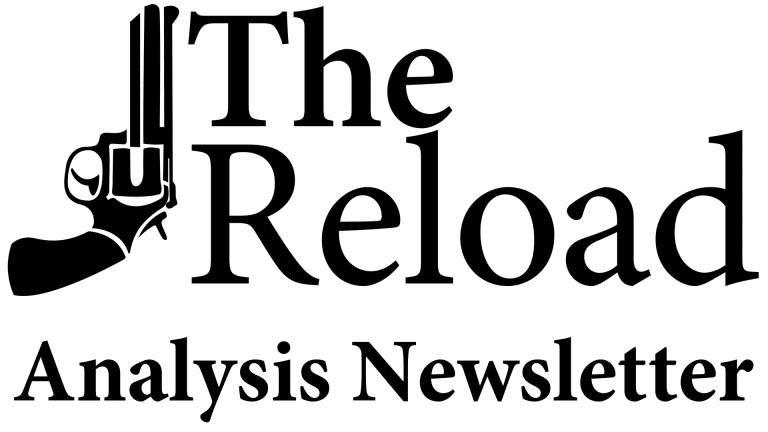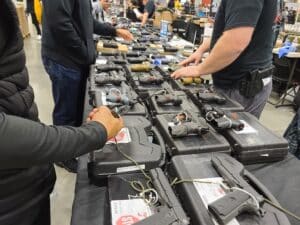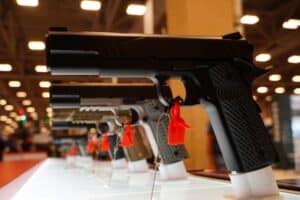The man who murdered the CEO of UnitedHealthcare has created a media firestorm that’s likely to persist the longer he remains on the run. The gun he used has been plastered on every TV and phone out there since then.
The NYPD has suggested the gun may be a B&T VP9, a modern replica of a famous British spy gun from WWII. However, as I explain in my piece and in my most recent CNN interview, the video of the killing proves otherwise.
Still, the shooter’s decision to pair that gun with a silencer presents a new challenge for advocates of the device’s deregulation. Contributing Writer Jake Fogleman explains why, just as silencer deregulation was gaining some renewed steam, the brazen killing could slow it back down–even if the silencer was more of a hindrance to the killer than an advantage.
Plus, George Mason University Professor Robert Leider joins the podcast to discuss what ATF strategy would be most effective for gun-rights advocates.
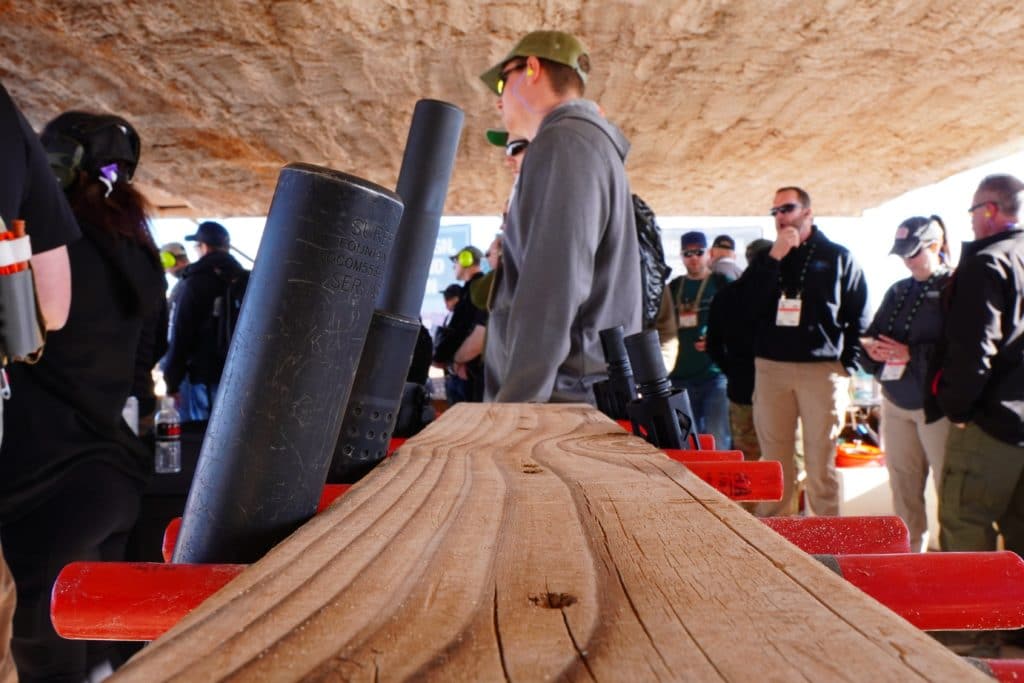
Analysis: The Potential Political Fallout from CEO Killer’s Silencer [Member Exclusive]
By Jake Fogleman
Gun-rights advocates have been building momentum for silencer deregulation headed into the next Trump Administration. The assassination of a high-profile health insurance executive could scuttle that effort.
On Wednesday, a masked assailant shot and killed UnitedHealthcare CEO Brian Thompson outside a Manhattan hotel. While the identity and whereabouts of the gunman are still unclear, surveillance footage of the murder shows that he used a semi-automatic pistol equipped with some kind of silencer–more accurately labeled a sound suppressor by the industry. Because suppressors are almost never used in crime, that facet of that attack has already garnered significant media attention.
“In all of my years of law enforcement, I have never seen a silencer before,” New York City Mayor Eric Adams (D.) said in a MSNBC interview. “And so that was really something that was shocking to us all.”
Prior to the incident, gun-rights advocates had been riding a cultural wave of growing support for suppressors both within and even beyond the gun-owning community that they hope to translate into policy change.
The ATF dramatically improved its approval times for suppressor purchases earlier this year, down from several months to just a few days or even hours in some cases. This erased a practical hurdle that deterred many from buying in the past, and it coincided with a significant uptick in suppressor ownership.
In October, the National Shooting Sports Foundation released new data from the ATF that shows Americans own approximately 4.9 million suppressors. That’s up from the 2.6 million registered suppressors when the ATF last disclosed the data in May 2021.
In addition to the near doubling of civilian suppressor ownership over the last three years, a major medical organization publicly endorsed their usage for the first time late last month.
“Sound suppressors are mechanical devices attached to the barrel of a firearm designed to reduce harmful impulse noise of firearms at its source,” the American Academy of Otolaryngology–Head and Neck Surgery (AAO-HNS) statement reads. “CDC research has shown that ‘The only potentially effective noise control method to reduce [shooters’] noise exposure from gunfire is through the use of noise suppressors that can be attached to the end of the gun barrel.’ Suppressors reduce muzzle blast noise by up to 30 dB.”
In turn, gun-rights advocates are looking to press their political advantage next year with an incoming Republican trifecta led by a President-elect who has pledged to support their policy goals.
Beyond measures like national concealed carry reciprocity, one of the most common legislative goals pushed by gun-rights advocates in recent years has been suppressor deregulation. The Hearing Protection Act, which would remove suppressors from the purview of the National Firearms Act, has been introduced by Congressional Republicans multiple times in recent years and enjoys the backing of virtually every prominent gun-rights organization.
Passage of the act was already something of a long shot before Wednesday, given the narrow majorities Republicans will have in both the House and Senate and uncertain appetite across their membership. It has become even more challenging following the device being used in a high-profile murder that was caught on camera and broadcast across the globe.
The imagery of the killing will likely serve to reinforce the pre-existing public image that suppressors are primarily tools for assassins, making the fight that much harder for lawmakers and advocates. Gun-control groups have long argued suppressors are unnecessary for hearing protection, and the hearing-dangerous noise levels produced by unsuppressed gunshots are actually a sort of safety feature themselves because they do a better job of alerting people to an active shooting. But, much like Hollywood movies, they have also consistently framed the devices as mostly useful for killers trying to mask their attacks.
“In the wrong hands, such weapons can be used to ambush unsuspecting victims,” Greg Lickenbrock wrote of suppressed pistols in a story about Wednesday’s killing that was published by Everytown for Gun Safety.
Suppressor deregulation advocates will face an especially hard fight if they aren’t able to garner Donald Trump’s support, which is quite possible given the mercurial nature of the President-elect when it comes to gun policy. After all, the last time a suppressor was used in a high-profile crime—the 2019 Virginia Beach shooting—President Trump even flirted with the idea of banning them altogether.
“I’d like to think about it. I mean, nobody’s talking about silencers very much. I did talk about the bump stock, and we had it banned, and we’re looking at that,” Trump told Piers Morgan on Good Morning Britain in June 2019. “I’m going to seriously look at it.”
Beyond the prospect of federal de-regulatory reform being scuttled, the more likely venue for political fallout will be among the states. Only eight states (including New York) and the District of Columbia currently prohibit civilian ownership of suppressors, but lawmakers in the remaining 42 states could easily use the incident as a catalyst to join their ranks.
The state response to the sudden prominence of bump stocks is instructive here.
Bump stocks existed on the commercial market for many years in relative obscurity to all but the most dedicated of gun hobbyists and were seldom, if ever, involved in any violent crime. That was until a gunman used numerous firearms, some equipped with the devices, to murder 60 people at a Las Vegas concert in 2017. Though that remains one of the only high-profile instances of a bump stock being used in violent crime, it prompted the first Trump Administration to ban the devices by executive action that the Supreme Court declared unlawful, and 16 states (as well as some cities) quickly adopted bans of their own in the years that followed.
While the UnitedHealthcare CEO’s assassination doesn’t come close to the Vegas shooting in terms of the death toll, it is a highly visible heinous act that could lead to a similar cascading policy response.
It’s too early on in the aftermath of the killing to know for sure what the political reaction will be. Law enforcement has not yet caught the killer or recovered the weapon involved. So, we don’t even know if a commercial silencer was used. The shooter possibly could have used an oil filter, solvent trap, or some other makeshift contraption. That’s one possible explanation for why the shooter had so many weapon malfunctions during his attack.
The use of a makeshift or otherwise illegally procured suppressor could blunt the potential political fallout for deregulation advocates. After all, there wasn’t much of a serious movement to go after civilian suppressors after the Monterey Park mass shooting in January 2023, where a gunman killed 11 with a handgun outfitted with a homemade suppressor.
Either way, both the incident and the attention it’s received have likely worsened the odds of increasing public acceptance of suppressor ownership. It will be a taller task than before for gun-rights advocates to loosen the regulatory constraints around suppressors now that grainy surveillance video of a mystery man killing somebody in cold blood with one is playing on loop around the world–even if the suppressor likely did more to hinder than help him.
Podcast: What Should Trump Do with the ATF? (Ft. GMU Professor Robert Leider) [Member Early Access]
By Stephen Gutowski
This week, we’re looking ahead at the next four years of gun policy.
With Donald Trump coming back into office having already promised to fire the current ATF director, it’s an open question of what he might do with the agency. That’s why we have George Mason University Professor Robert Leider back on the show to hear his view of what moves gun-rights activists should pursue. Leider has studied the administrative side of gun policy.
He argues it would be more effective for activists to push for a competent ATF leader to institute pro-gun reforms than to try to cripple the organization. He noted it’s very unlikely legislation to disband the ATF or to repeal the underlying laws it enforces could pass Congress. He said the ATF’s responsibilities could be moved to another federal law enforcement agency, like the FBI, but argued they could upset activists just as much, if not more.
Leider believes Trump would be better off appointing a new director who understands how the agency operates. He said there are a lot of ways to affect federal gun policy without changing the underlying laws. That’s because federal law specifically provides the agency with a lot of leeway on enforcement.
You can listen to the show on your favorite podcasting app or by clicking here. Video of the episode is available on our YouTube channel. An auto-generated transcript is here. Reload Members get access on Sunday, as always. Everyone else can listen on Monday.
Plus, Contributing Writer Jake Fogleman and I break down what we can glean about the UnitedHealthcare CEO’s assassin based on surveillance footage of his gun. We also cover President Joe Biden’s pardon of his son Hunter and what that means for Second Amendment challenges related to his gun crimes. We wrap up by discussing the trend of Trump’s law enforcement cabinet picks having a history of supporting red flag laws, the US House of Representatives’ new legal brief in Smith and Wesson’s upcoming Supreme Court case, and what to make of new reports that Trump’s relationship with the NRA has soured.

Analysis: What the CEO Killer’s Gun Tells Us About Him [Member Exclusive]
By Stephen Gutowski
The man who murdered the CEO of UnitedHealthcare remains unknown and at large, but the gun he used and how he used it reveal some key details about him.
On Wednesday, a masked man ambushed Brian Thompson outside a New York City hotel. He fired three shots, killing Thompson. Then he fled and remains on the run as of Friday morning.
Video of the murder (warning: it’s graphic) and a few other important pieces of evidence show the killer used an unusual setup that provides some insight into his skill level and preparedness.
One clear takeaway from the video, despite its blurry nature, is the type of gun the shooter used. While the images aren’t clear enough to identify a specific make or model for the gun or silencer, a frame-by-frame review of the surveillance footage that captured the killing shows the shooter was using a semi-automatic pistol with a silencer attached to it. The video is definitive on this point because you can see the slide of the semi-automatic recoil and cover part of the shooter’s hand after the first shot.
However, the video also shows the gun was not properly set up and didn’t function properly. The shooter’s actions suggest it wasn’t able to extract a spent casing, load a new round, and fire that round like it is designed to do. That’s why he manually racks the slide between each shot and misfire (police reportedly recovered three spent casings and three live rounds from the scene). Oddly, the shooter seems to anticipate this problem and isn’t surprised by it because, after the first successful shot, he immediately goes to rack the slide and manually cycle the gun.
That implies he must’ve had some experience shooting that particular gun with that particular silencer and understood the firearm wouldn’t cycle properly on its own. It’s strange he would use a gun he knows will malfunction, especially since the silencer doesn’t give him much of a real-world advantage.
After all, the term “silencer” is a misnomer. It’s more of a marketing term coined by the device’s inventor than an accurate description of what it does in real life. Unlike in the movies, a silencer does not turn deafening gunshots into whispers–certainly not for the 9mm rounds the shooter used in this case.
A silenced 9mm shot is undoubtedly quieter than an unsilenced one, but the decibel level is still louder than a jackhammer or an ambulance siren. The effect of a firearm silencer is more akin to that of a car muffler than a magic quiet spell. That makes sense since mufflers were invented by the same person and employ the same technique to, well, muffle the sound of a car that silencers do with a gunshot.
Additionally, the video shows he carried out this killing not just in the middle of New York City in the daytime but also right in front of somebody (who wisely flees as the shooting begins). Another person was sitting in the SUV next to where the shooting happened as well. So, if the shooter was hoping the silencer would help mask his attack, he ended up making any sound suppression moot with how brazen his actions were.
The silencer also added significant length and bulk to the gun, which makes it more difficult to conceal and maneuver. So, the silencer provided little real-world advantage and a lot of drawbacks. Yet, he used it anyway.
Outside of movies and TV, it’s rare to see a silencer used in a targeted killing like this.
Regardless, the video reveals more information. After the first shot, the attacker isn’t successful at manually cycling the gun on his initial attempt to reload the chamber. He tries to take a second shot, but the gun doesn’t fire. So, he racks the slide again and then successfully fires the gun a second time.
He then starts walking and tries to manually cycle the gun again. This time, he hits the back of the slide in an attempt to make sure the firearm is fully in battery. He is eventually able to get a third shot off before fleeing.
Modern semi-automatic pistols won’t fire if the slide isn’t fully forward. The shooter’s attempt to ensure the gun is in battery implies he has some level of training. He likely has experience beyond an introductory firearms course. He’s probably been shooting more than a couple of times.
However, most of the more advanced firearms instructors teach students to tap the magazine and rack the slide in the case of a misfire or malfunction. He doesn’t ever attempt that maneuver and, though remarkably calm, fumbles with the gun repeatedly.
Those are further indicators that he’s perhaps more of an intermediate shooter than an expert.
It turns out he was ejecting live rounds from the gun when he was trying to clear the malfunctions. So, he may not have actually needed to manually cycle the gun at some points since it was loading live rounds. That suggests that while he seemed to know going in the gun wouldn’t function properly, he didn’t have a full grasp of why that was and what the right solution should be.
Also, pictures of the live rounds found at the scene show they are full metal jackets. Most advanced shooters use those rounds for target practice because they are plentiful and comparatively cheap. However, full metal jackets are more likely to pass straight through a person, which makes them less effective for stopping your target. That’s why police and people who carry for self-defense use hollow-point bullets, which expand on impact and are more likely to impart all of their energy in the target.
He either didn’t understand that difference or perhaps couldn’t find hollow point ammo since some states restrict the sale of those bullets. Of course, some states also ban silencers–including New York. Just like the ammo, the reason he went ahead with an improperly set up silencer could be that it was all he had access to in the time he had to prepare.
While the video and other available evidence tell us the gun and ammunition he used and how he used them, it only provides limited insight into why exactly he used the gun he did or why he used it in the way he did. It doesn’t allow us to draw absolute conclusions. It just provides some fuel for speculation.
Still, all things considered, the evidence suggests this is somebody who has some firearms training. He has some knowledge of how to clear a malfunction. He has some experience with the gun he used.
But he’s also not an expert and was willing to go ahead with a gun he seemed to know wasn’t going to function reliably. That hindered his assault. However, since an armed assailant who is ambushing an unarmed victim doesn’t need everything to go perfectly to accomplish their goal, it didn’t matter much in the end.
Honestly, it feels like he’s play-acting what he’s seen assassins do in movies. Reports that law enforcement found messages written on the rounds recovered at the scene reinforce that feeling. It all seems like somebody imitating well-established media tropes of what killers do, down to the silencer and cryptic messages.
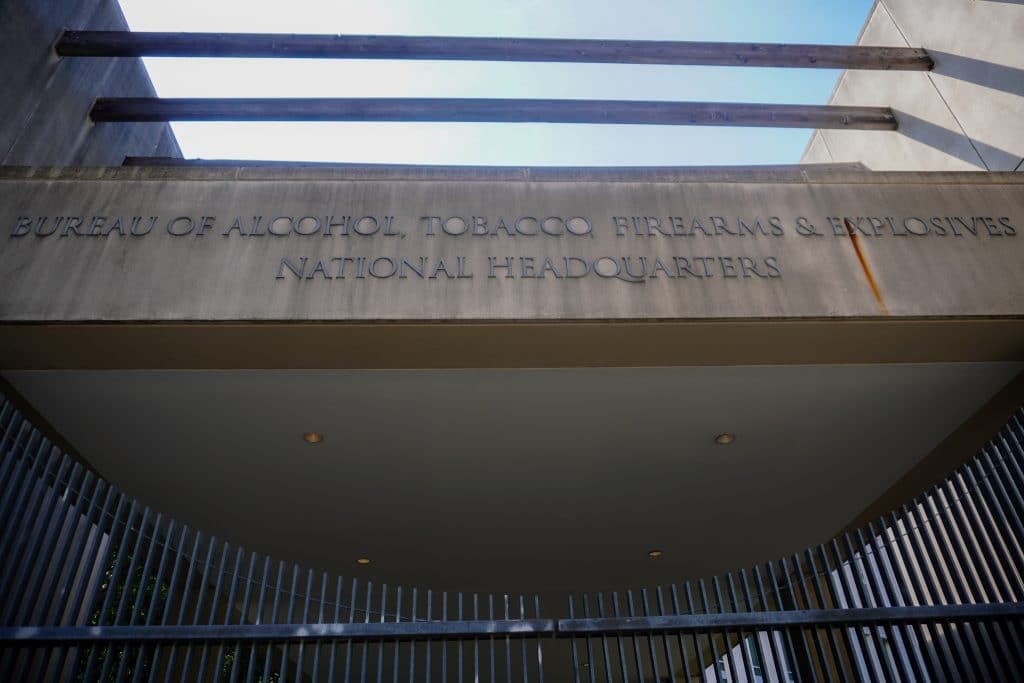
Analysis: Gun-Rights Advocates Would Benefit More From ATF Reform Than the Agency’s Elimination
By Robert Leider
President Donald Trump’s successful 2024 campaign has Second Amendment advocates facing a dilemma. They can either try to use their political capital to destroy the Bureau of Alcohol, Tobacco, Firearms, and Explosives (ATF) or work within it to accomplish their preferred policy goals.
At the top of some advocates’ wish lists is finding an ATF director who will shut down or otherwise cripple ATF. Even in the unlikely event they were successful, shutting down ATF could backfire spectacularly without substantial, and likely unobtainable, federal firearms law reforms. Instead of trying to eliminate ATF, gun advocates would fare better working through ATF to implement their preferred regulatory reforms.
Most regulations that burden gun owners and dealers come directly from federal firearms laws: the Gun Control Act of 1968 and the National Firearms Act. The Gun Control Act—not ATF—requires individuals to become licensed dealers if they sell guns primarily for profit. It generally prohibits selling guns in interstate commerce, except by individuals who have federal firearms licenses. It restricts the importation of firearms that lack a sporting purpose. And both the Gun Control Act and the National Firearms Act impose significant restrictions on short-barreled rifles and shotguns and firearm suppressors (often called silencers).
Shutting down ATF would do nothing to relieve the legal restrictions imposed by federal gun-control laws. These restrictions stem directly from laws passed by Congress, and only Congress can change or eliminate them. Gun advocates are unlikely to find sixty votes in the Senate to repeal or reform most federal gun laws. Moreover, to the extent that Congress has delegated some authority to regulate firearms with the executive branch, federal firearms laws place the burden of regulating firearms with the Attorney General, not with ATF. ATF only exercises functions that the Attorney General has delegated. If ATF did not exist, the Attorney General would either need to handle these functions personally or delegate the functions to another bureau within the Department of Justice.
Either option would be counterproductive for gun owners. The Office of the Attorney General lacks the ability to issue over 100,000 federal firearm licenses and to approve approximately 1,000,000 National Firearms Act applications. Given this, it’s likely these functions will get transferred to another bureau, such as the Federal Bureau of Investigation (FBI). A move like that would likely come at a high cost and comes with the risk of the transfer going poorly.
Moreover, the FBI (or another Department of Justice agency) may end up regulating firearms much the same way that ATF has to this point.
In any case, gun owners will still face the regulations imposed by federal firearms laws. Neither the Gun Control Act nor the National Firearms Act conditions its regulations on the Attorney General having a functional process to regulate firearms. Whether or not a smooth and timely process to issue federal firearms licenses exists, federal law will continue to prohibit interstate firearms sales for those without them. Federal law will also continue to prohibit the importation of firearms that the Attorney General (or another designee) finds are not “generally recognized as particularly suitable for sporting purposes.” Federal law will continue to register and tax certain firearms. And federal law will continue to require the Attorney General’s permission to transport certain firearms regulated by the National Firearms Act across state lines.
Removing these functions from ATF would also complicate the ability of gun advocates to lobby presidential administrations to appoint gun-friendly directors of the agency in charge of regulating firearms. Right now, an ATF director candidate’s position on gun control dominates the debate on whether he will be nominated and confirmed. (No one seems to care where an ATF nominee stands on alcohol and tobacco enforcement.) In contrast, political debates on selecting the Attorney General or the FBI director involve much more than gun politics. When appointing individuals to these offices, presidents may be more willing to look past their prior pro-gun control positions to achieve other political objectives for these offices.
Instead of using their political capital to try and dismantle the ATF, gun advocates would likely see more success working within the system. While federal firearms laws cannot be repealed by executive action, they still delegate significant power to the Attorney General (who subdelegates to ATF) on how the laws are implemented. The Trump Administration could shift many ATF policies in their favor.
Let me give two illustrative examples.
Although federal law restricts the importation of firearms without a finding that the firearms are useful for sporting purposes, ATF determines what constitutes “sporting purposes” for firearm importation. The Trump Administration is no more bound to the ATF’s definition of sporting purposes from the Clinton Administration than the Clinton Administration was bound by the Reagan Administration’s definition. Consequently, there is nothing stopping the Trump Administration from having a more expansive conception of what constitutes a legitimate sporting purpose.
The Trump Administration can also guide how ATF exercises its investigative and prosecutorial discretion over federal firearm licensees. This could include reversing the Biden Administration’s “zero tolerance” policies that have led to federal firearms licensees being revoked over minor paperwork violations.
Reforming federal firearms policies requires extensive technical knowledge of administrative law combined with a pragmatic and realistic policy agenda. If gun advocates want to translate their electoral success into tangible policy changes, they will need to work within the regulatory state that many of them despise rather than trying to overthrow it.
That’s it for now.
I’ll talk to you all again soon.
Thanks,
Stephen Gutowski
Founder
The Reload

